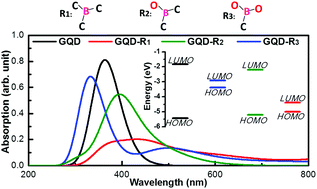当前位置:
X-MOL 学术
›
J. Mater. Chem. C
›
论文详情
Our official English website, www.x-mol.net, welcomes your
feedback! (Note: you will need to create a separate account there.)
Tuning the electronic and optical properties of graphene quantum dots by selective boronization†
Journal of Materials Chemistry C ( IF 5.7 ) Pub Date : 2018-09-28 00:00:00 , DOI: 10.1039/c8tc03863e Jianguang Feng 1, 2, 3 , Hongzhou Dong 1, 2, 3 , Beili Pang 1, 2, 3 , Yingjie Chen 1, 2, 3 , Liyan Yu 1, 2, 3 , Lifeng Dong 1, 2, 3, 4, 5
Journal of Materials Chemistry C ( IF 5.7 ) Pub Date : 2018-09-28 00:00:00 , DOI: 10.1039/c8tc03863e Jianguang Feng 1, 2, 3 , Hongzhou Dong 1, 2, 3 , Beili Pang 1, 2, 3 , Yingjie Chen 1, 2, 3 , Liyan Yu 1, 2, 3 , Lifeng Dong 1, 2, 3, 4, 5
Affiliation

|
The optical properties of graphene quantum dots (GQDs) can be modified through introducing heteroatoms, including doping heteroatoms and covalent bonding with specific groups. Hence, we use density functional theory (DFT) and time-dependent (TD) DFT to understand the effects of boron doping configurations (i.e., BC3, BC2O and BCO2) on the electronic and optical properties of GQDs. Absorption spectra and HOMO–LUMO gaps are quantitatively calculated to study the correlations between the optical properties and electronic structure with different boronization and oxidation patterns. It demonstrates that BC2O can induce a red shift of absorption spectra, while the absorption spectra of the surface doped GQD with BCO2 exhibits a blue shift. According to the excited state analysis, BC3 plays an important role in determining the electronic transition, while the effects of BC2O and BCO2 on tuning the electronic and optical properties of GQDs are dictated by their hybridization form of carbon. Meanwhile, it indicates that the coexistence of B atoms and oxidized B bonding configurations can help charge transfer in the absorption process.
中文翻译:

通过选择性硼化来调整石墨烯量子点的电子和光学性质†
可以通过引入杂原子(包括掺杂杂原子和与特定基团共价键合)来修饰石墨烯量子点(GQD)的光学性质。因此,我们使用密度泛函理论(DFT)和时变(TD)DFT来了解硼掺杂结构(即BC 3,BC 2 O和BCO 2)对GQD的电子和光学性质的影响。定量计算吸收光谱和HOMO-LUMO间隙,以研究不同硼化和氧化模式的光学性质与电子结构之间的相关性。它证明了BC 2O可以引起吸收光谱的红移,而BCO 2掺杂的表面掺杂GQD的吸收光谱呈现蓝移。根据激发态分析,BC 3在确定电子跃迁中起重要作用,而BC 2 O和BCO 2对调节GQD的电子和光学性质的影响取决于它们的碳杂化形式。同时,这表明B原子和氧化的B键结构的共存可以在吸收过程中帮助电荷转移。
更新日期:2018-09-28
中文翻译:

通过选择性硼化来调整石墨烯量子点的电子和光学性质†
可以通过引入杂原子(包括掺杂杂原子和与特定基团共价键合)来修饰石墨烯量子点(GQD)的光学性质。因此,我们使用密度泛函理论(DFT)和时变(TD)DFT来了解硼掺杂结构(即BC 3,BC 2 O和BCO 2)对GQD的电子和光学性质的影响。定量计算吸收光谱和HOMO-LUMO间隙,以研究不同硼化和氧化模式的光学性质与电子结构之间的相关性。它证明了BC 2O可以引起吸收光谱的红移,而BCO 2掺杂的表面掺杂GQD的吸收光谱呈现蓝移。根据激发态分析,BC 3在确定电子跃迁中起重要作用,而BC 2 O和BCO 2对调节GQD的电子和光学性质的影响取决于它们的碳杂化形式。同时,这表明B原子和氧化的B键结构的共存可以在吸收过程中帮助电荷转移。











































 京公网安备 11010802027423号
京公网安备 11010802027423号